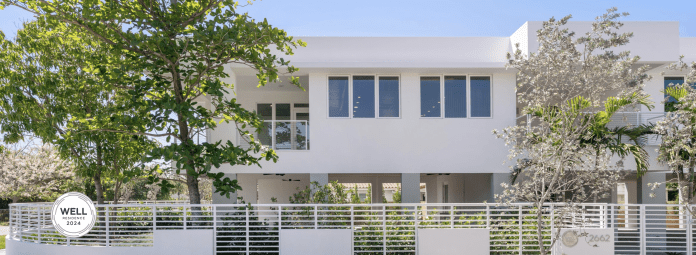|
Getting your Trinity Audio player ready...
|
As many as 100 million houses will be built in the United States in the first half of this century, according to the National Research Council. Miami is one of the fastest growing parts of the country, but home ownership in South Florida is not always a healthy experience, mentally or physically because of the materials and strategies used in modern home construction.
I moved my family into a new construction townhome in Coconut Grove in January 2020, just before the pandemic, and by Thanksgiving it was a nightmare. First, a pipe ruptured in the dining room wall, creating a hidden fountain that turned drywall to mud, ruined the fiberglass insulation, and required an expensive fix. Second, we found mildew around light switches in our daughter’s room, musty smells behind the shower and yellow stains on the ceiling – all too common realities in South Florida homes.
Something going wrong inside the wall or above the ceiling is not just a hit to the wallet, but also erodes our peace of mind. The connection between humidity, fragile materials, and human health is well known. Once wet, drywall grows mold and mildew, and moisture in the walls attracts pests. Dust from all the repairs collects in the AC ducts. These conditions can cause allergies, depression and more. The truth is we don’t have to live this way as technology and new ideas are laying the foundation for homebuilding with people’s health at the core.
The International WELL Building Institute, the global authority on healthy buildings, organizations and communities, is encouraging a commitment to people-first places by recently certifying a home in Miami’s Silver Bluff neighborhood as the first WELL residence in the world. The home, named CM1, incorporates a variety of innovations that point the way towards a healthier future.
Here are some of the ways that your next home can focus on the well-being of you and your family, and also prove to be more economical over a lifetime:
Remove the Drywall: Drywall is a technology from the 1930s that has become ubiquitous across the United States, but it is not inherently well-suited to humid environments. In the future, architects, developers and builders can replace drywall with more durable materials, such as concrete, metal, glass or wood panels. These materials last longer and protect your investment as they don’t need replacing if they get wet.
More Room and Value: Homes can become up to 20% larger by eliminating hidden cavities or voids in walls and ceilings inside the same space we live and sleep in. New homes built this way will offer more livable space on the same-size lots.
Better, More Accessible Plumbing: Centralizing plumbing results in shorter and more vertical designs, so drains work better. By adding removable paneling to cover these areas, all plumbing can be accessed for diagnosis, repair, or future upgrades in less time and at a lower cost.
Electrical Conduits in Floor Slabs, Ceilings: Designing electrical conduits into floors and ceilings clears space behind the walls and will offer homeowners more flexibility for locating their appliances, technology and enjoying their home.
Ductless AC: Long networks of enclosed ductwork above the ceiling are a standard architectural feature in our warm climate, but they represent a large threat to indoor air quality that grows worse over time, with ducts never effectively cleaned. The older the house, the more dust in our air supply. Switching to smaller “minisplit” AC units means room-by-room temperature control, no AC closets and greater energy efficiency.
With homeowners increasingly health-conscious, climate change ongoing, and insurance companies already offering credits for participation in green building programs such as LEED, the time is now for rethinking the way we build in South Florida – to make mental and physical wellness the priority.
Author Note:
Ted Caplow, Ph.D., is an entrepreneur, engineer, a patented inventor and principal of Caplow Manzano, whose CM1 home in Miami was awarded the first WELL Residence certification in the world. Dr. Caplow is the creator of the Science Barge and a founder of New York Sun Works and BrightFarms and holds an advisory position at the University of Miami Department of Civil and Architectural Engineering.






